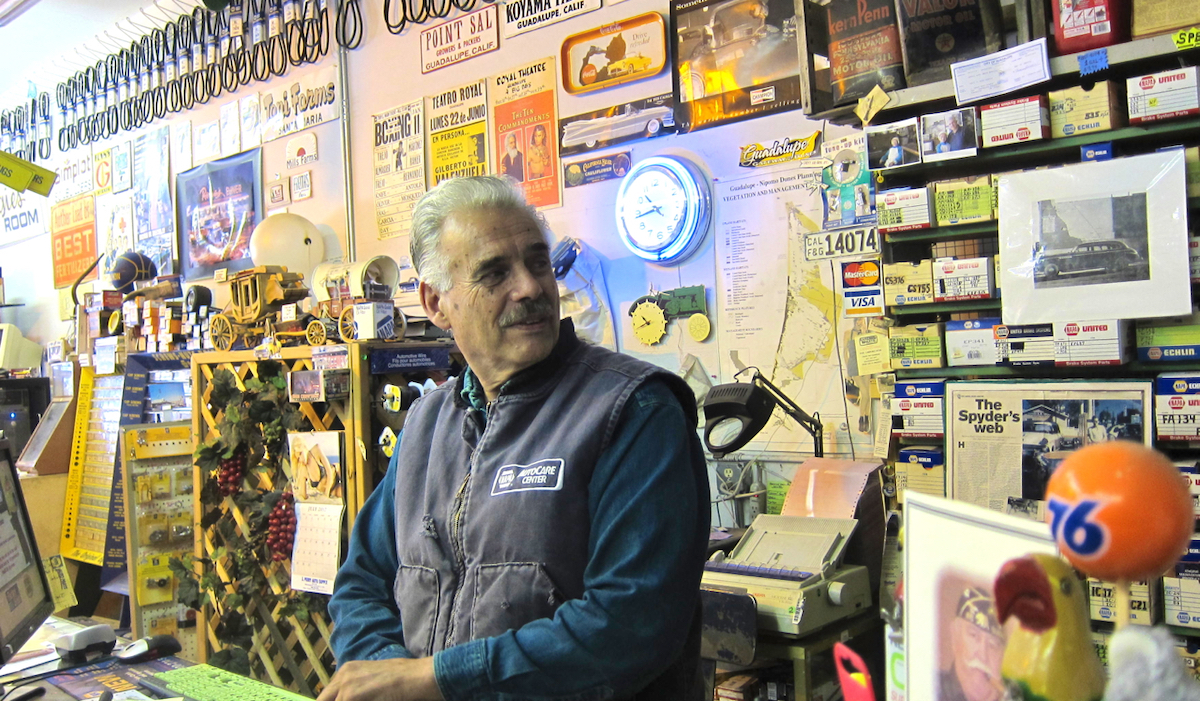A Trip Down Memory Lane with Guadalupe’s Johnny Perry
Bright Lights and Bragging Rights

This was Johnny Perry: musician, raconteur, unofficial historian, and proprietor of the NAPA auto parts store (which also doubled as a museum of local artifacts) on the main drag of Guadalupe. Sadly, the place has since closed, and Johnny died last year, but it’s nice to remember colorful people and small-town curiosities. The store held not just a good supply of auto parts, but an 1840 adobe brick; vintage photos, posters, and bumper stickers; and even the plaster paw of a sphinx from Cecil B. DeMille’s 1923 production of The Ten Commandments, filmed at the nearby Guadalupe-Nipomo Dunes. But the best attraction was Johnny himself, a veritable fount of information about Guadalupe — especially the good times.
A photograph on the wall showed a teenaged Johnny wearing a striped serape and playing the sax alongside three other musicians at a Mexican Independence Day parade in the 1950s. “These celebrations predated Santa Barbara’s Old Spanish Days,” he said, adding that they were so big, folks would miss work the next day. His fondness for music went back to his boyhood days at the family ranch at Oso Flaco and a song he heard there, “Sentimental Journey,” played over and over. “I liked the sound,” said Johnny. “Tenor sax. So I thought, ‘I’ll learn that.’”
And he did. From the school band in 4th grade, he parlayed his talents to playing at dances, eventually becoming part of a band called The Biscaynes, who opened for Jan and Dean in Pismo Beach and were the lead band at the Beach Boys’ first concert on June 2, 1966. In a display case at the store, there was a 45 rpm vinyl record of the Biscaynes’ biggest hit, “Church Key,” but Johnny’s son Eric switched on his computer, found the sound clip, hit play, and music filled the shop. It was a classic surf tune of the early ’60s — guitar, drum, organ, and Johnny’s sax in an arrangement so lively, you’d want to dance … or drive along the California coast … or simply stand there, grinning. (What can I say? It was one of those “I love my life” moments.)
“We never made no money at all,” said Johnny, “…just bright lights and braggin’ rights.” And wonderful memories, too. To hear Johnny tell it, Guadalupe was a place for dancing and partying all night long, and he was happy to participate. “In one place was western music,” he recalled, “over there was Russian; down the street around the corner they had mariachis. Those three blocks … people walkin’ back and forth … then everybody closed at two, and they’d go an’ fill up all the restaurants…. People would come from Santa Maria, Lompoc, Arroyo Grande….”
I interrupted for a quick backtrack: “You mean 2 a.m.? People were going to the restaurants at 2 a.m.?”
Sign up for Indy Today to receive fresh news from Independent.com, in your inbox, every morning.
“Oh yeah,” says Johnny. “You get hungry after dancing all night. People would be leaving the restaurants at 3 a.m., 4 a.m. We used to play the Rose Garden in Pismo, and we got our pay … I dunno … 20 bucks, something like that … well, most of it went for breakfast right after. Then you go home and give your wife 10 dollars.”
Johnny’s shop was housed in the old Druid Temple building on Guadalupe Street. In addition to serving as the lodge for Druid business, the upstairs area at one time was used for Mexican rosaries and wakes, where people would take shifts sitting with the deceased, praying, and drinking tequila. It was a tough job carrying a coffin up and down those stairs, especially post-tequila, and Johnny decided early on he would discontinue that use of the building.
Back at ground level, there was at one time a post office whose mail slots and signs (DROPS, MONEY ORDERS, STAMPS) could still be seen in a corner of the store. Later, briefly and incongruously, the place served as a skating rink, from which Johnny said he was once kicked out for having too much fun and elbowing another skater.
A block or two down, you’d hear music coming out of the Vet’s Hall, where dances were held. (“Girls would be on one side, guys on the other….”) And across the street, there was the theater, open seven days a week, and a genuine melting pot experience. “Weekends, Monday, and Wednesday, they’d show American movies,” Johnny recalled. “Tuesday and Thursday, it was Mexican, and on Fridays, it would be Japanese, Filipino, or Chinese. We even liked to go to those because it was fun to hear the way they talked. Then we’d run over to Snappy Lunch and have our cheeseburger and fries.”
Contemporary kids, upon hearing about the rink, the theater, the dances, and the seemingly nonstop fun, used to ask Johnny, ‘Why don’t we have stuff like this anymore?”
It’s a good question.
Support the Santa Barbara Independent through a long-term or a single contribution.



